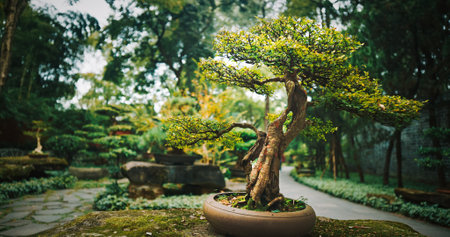Introduction to Feng Shui and British Gardens
Feng Shui, an ancient Chinese practice, centres on harmonising individuals with their surrounding environment through the strategic arrangement of space, objects, and natural elements. The core principles involve balancing the five elements—wood, fire, earth, metal, and water—while ensuring a smooth flow of qi (energy) throughout a space. These guidelines are historically rooted in Eastern philosophy but have found resonance across various cultures due to their emphasis on balance, wellbeing, and positive energy.
In contrast, traditional British garden design is renowned for its structured elegance, seasonal blooms, and an inherent celebration of local flora. Hallmarks include manicured lawns, symmetrical layouts, winding paths, perennial borders, and features such as ponds or follies that reference a sense of history and place. British gardens often reflect a deep connection to both nature and heritage, blending wildness with refined order.
The purpose of integrating Feng Shui principles into British garden design is to create outdoor spaces that not only showcase aesthetic beauty but also promote a deeper sense of tranquillity and holistic wellbeing. By combining these two philosophies, gardeners can develop gardens that offer visual delight while fostering harmony between people and nature—a thoughtful synthesis suited to modern British lifestyles seeking both tradition and innovation.
2. Core Feng Shui Concepts and Their Relevance
Understanding the foundational principles of Feng Shui is essential for appreciating how they can influence British garden design. At its heart, Feng Shui seeks to harmonise individuals with their surrounding environment by optimising the flow of energy, or Qi. To provide a practical framework, three core concepts stand out: Qi, the Five Elements (Wu Xing), and Bagua. Each offers distinct guidance that can be adapted to suit the unique characteristics of British gardens, such as lawns, flowerbeds, hedgerows, and patios.
Qi: The Flow of Energy in Outdoor Spaces
Qi (pronounced “chee”) refers to the vital life force believed to circulate through all living things and spaces. In a British garden context, Qi is observed in the movement of wind between shrubbery, the gentle curve of pathways, and even the arrangement of seating areas. Ensuring an unblocked, meandering flow encourages relaxation and vitality. For example, instead of placing straight and narrow paths that rush Qi directly from gate to door, curved or gently angled walkways slow down the energy, creating a more serene atmosphere.
The Five Elements: Integrating Wu Xing into British Gardens
The Five Elements—Wood, Fire, Earth, Metal, and Water—are used in Feng Shui to balance energies within a space. Each element is associated with certain colours, shapes, and materials commonly found in UK gardens. Below is a table outlining practical applications:
| Element | Associated Feature | Practical Example (British Garden) |
|---|---|---|
| Wood | Tall plants/vertical lines | Rowan trees or trellis with climbing roses |
| Fire | Red/orange tones & pointed shapes | Poppies, tulips, or a brick barbecue area |
| Earth | Flat surfaces & earthy colours | Stone patios or gravel borders |
| Metal | Circular forms & metallic hues | Copper planters or wrought iron benches |
| Water | Curved shapes & blue/black colours | Ponds or water features with gentle movement |
A well-designed British garden incorporates these elements thoughtfully—for instance, balancing wooden fencing (Wood) with stone paving (Earth), and perhaps adding a small pond (Water) for tranquillity.
Bagua: Mapping Energy Zones onto British Plots
The Bagua map divides a space into eight zones around a central point, each corresponding to aspects such as wealth, health, relationships, and creativity. While traditional Bagua is often applied indoors, it can also be transposed onto outdoor spaces like typical semi-detached gardens or allotments common in Britain. For example:
- The rear left corner (viewed from the house) might be enhanced with vibrant flowers for prosperity.
- The centre could feature an open lawn area symbolising health.
- The right side may include seating for fostering friendships and community spirit.
This methodical approach helps guide decisions about plantings, features, and focal points so every section of a British garden serves both aesthetic and energetic purposes.
![]()
3. Historic Parallels and Cross-Cultural Influences
The relationship between Chinese and British gardening traditions is more intricate than it might first appear. While separated by geography and culture, both traditions have long placed emphasis on harmony, symbolism, and the thoughtful arrangement of natural elements. The era of increased trade and exploration in the 17th and 18th centuries provided a fertile ground for cross-cultural exchange, particularly as artefacts, texts, and even living plants travelled between East Asia and Britain.
Subtle Influences in Design Philosophy
British garden designers of the Georgian and Victorian periods, inspired by travelogues and imported goods from China, began to incorporate elements reminiscent of Feng Shui principles. Although not always directly acknowledged as such, features like winding paths, carefully sited water bodies, and asymmetrical layouts reflect an emerging appreciation for spatial balance—echoing the Chinese ideal of creating a landscape that harmonises with its surroundings.
Symbolism Across Cultures
Both Chinese and British gardens utilise symbolism extensively. In traditional Feng Shui, every element—be it water, rock, or plant—carries specific meaning and is positioned with intent. Likewise, British gardens often employ symbolic motifs: the inclusion of certain flowers to represent sentiment, or the use of classical statuary to evoke ideas of wisdom or virtue. Over time, British designers selectively adopted symbolic plantings (like peonies or bamboo) and ornamental features (such as moon gates) that had their roots in Chinese tradition.
Spatial Awareness and Flow
One striking cross-cultural parallel lies in the appreciation for spatial flow. Feng Shui stresses unobstructed energy movement (Qi), advocating for pathways that gently curve rather than cut straight lines across the landscape. This concept found echoes in Britain’s shift away from rigidly formal layouts toward more naturalistic, meandering garden paths popularised during the English Landscape Movement. The aim was not only visual pleasure but also an intuitive sense of well-being when moving through space—a principle at the heart of both traditions.
While direct references to Feng Shui are rare in historic British texts, the influence is evident in the subtle adoption of design approaches that prioritise harmony between people, structures, and nature. These cross-cultural exchanges have enriched both traditions, fostering innovation while honouring deep-rooted philosophies of landscape design.
4. Adapting Feng Shui to the British Climate and Context
When considering the integration of traditional Feng Shui principles into British garden design, one must thoughtfully adapt these ancient techniques to suit the UK’s distinctive climate, native flora, and unique landscape features. The United Kingdom’s temperate maritime climate brings about distinct seasonal variations, with cool, wet winters and mild summers, which necessitate a flexible approach to Feng Shui guidelines originally formulated for East Asian environments.
Understanding Seasonal Variations
Feng Shui places significant emphasis on balance and harmony with nature. In Britain, this means carefully selecting plants and design elements that thrive in fluctuating weather conditions. Traditional Chinese gardens often feature evergreens and water features; however, in the UK context, it is prudent to consider hardy perennials and robust shrubs that endure frost and extended rainfall without losing their structural integrity or aesthetic value.
Plant Selection: Harmonising Tradition and Locality
| Feng Shui Element | Traditional Plant Example | British Alternative |
|---|---|---|
| Wood | Bamboo | Silver birch, English oak |
| Water | Lotus, water lilies | Iris pseudacorus (Yellow flag iris), native pondweed |
| Fire | Red maple | Cornus sanguinea (Dogwood), poppies |
| Earth | Mosses, peonies | Heather, primroses |
| Metal | White peony | Daisy, snowdrop |
This table illustrates how core Feng Shui botanical symbols can be substituted with resilient species endemic to the UK, preserving both symbolism and sustainability.
Navigating Landscape Features
The undulating terrain and patchwork fields typical of the British countryside differ from the more controlled landscapes found in classical Chinese gardens. When adapting Feng Shui concepts such as ‘mountain’ (support) and ‘water’ (flow), British designers can reinterpret these using local hills or existing stone walls for support energy, while natural streams or rain gardens can fulfil the water element’s role. The use of meandering paths aligns well with both British landscape traditions and Feng Shui’s preference for gentle curves over sharp angles, promoting a nurturing flow of chi throughout the garden.
Shelter and Wind Direction Considerations
The UK is known for its blustery conditions, especially in coastal or exposed areas. Implementing windbreaks—such as hornbeam hedges or willow fences—serves dual purposes: protecting delicate plantings and harnessing beneficial chi by slowing strong winds in accordance with Feng Shui advice. Garden orientation should also consider prevailing south-westerly winds and optimise sunlight capture during shorter winter days.
Conclusion: Respectful Integration for Lasting Harmony
A successful synthesis of traditional Feng Shui with British garden design respects local environmental conditions while maintaining core philosophical intentions. By embracing indigenous flora, adapting structural features, and responding sensitively to climate patterns, designers can create outdoor spaces that are not only beautiful but also resonant with both cultural heritage and ecological realities.
5. Incorporating Feng Shui into Contemporary British Garden Design
Practical Guidance for Modern Gardens
Integrating traditional Feng Shui principles into contemporary British garden design requires both sensitivity to local culture and an understanding of the practical realities of British landscapes. Homeowners, landscape architects, and community groups can draw on core concepts—such as balance, energy flow, and harmonious placement—to create outdoor spaces that feel welcoming and revitalising. Start by assessing your garden’s orientation, taking note of sunlight, wind direction, and existing natural features. Use winding paths rather than straight lines to encourage gentle movement of ‘qi’ (energy) throughout the space—a technique that pairs well with the meandering lawns commonly found in British gardens.
Sustainability Meets Harmony
Sustainability is a key concern in the UK’s gardening culture. Fortunately, Feng Shui’s emphasis on natural materials and ecological balance aligns closely with sustainable practices. For example, use reclaimed stone for pathways or recycled timber for raised beds. Planting native species not only supports biodiversity but also reflects the Feng Shui value of working in harmony with one’s environment. Consider rainwater harvesting features positioned in the north or east corners to foster positive water energy while supporting eco-friendly irrigation.
Urban Spaces: Bringing Tranquillity to City Life
Urban British gardens—whether small backyards, balcony gardens, or communal green spaces—can benefit from Feng Shui by introducing elements that soften hard edges and create a sense of sanctuary. Vertical planting walls facing east or southeast can invite morning light and new beginnings, while strategic placement of reflective surfaces (like water bowls or mirrors) helps maximise available light and visual space. In shared urban gardens, designate quiet corners with seating surrounded by lush greenery to offer a retreat from city bustle; these zones align with the principle of creating peaceful ‘yin’ areas for rest and contemplation.
Community Gardens: Fostering Connection Through Design
Community gardens across Britain provide fertile ground for integrating Feng Shui principles at a larger scale. Encourage circular or oval gathering spaces instead of rigid squares to support inclusive energy flow among participants. Position tool sheds or compost bins in less prominent areas (ideally towards the northwest) to keep functional elements discreet yet accessible—a nod to both practicality and aesthetic balance. Involve local residents in the planning process to ensure the garden meets diverse needs and strengthens community bonds, a vital aspect of positive ‘qi’ circulation.
Real-World Example: The London Zen Garden Project
The London Zen Garden Project in Hackney offers a compelling case study: volunteers incorporated winding gravel paths, carefully placed boulders, and clusters of native ferns to evoke tranquillity within a busy urban setting. Rainwater was channelled into a central pond located in the east sector, symbolising growth and renewal according to Feng Shui tradition. Community feedback highlighted improvements not only in biodiversity but also in residents’ well-being—a testament to the practical benefits of this integrative approach.
Conclusion: A Harmonious Future
By thoughtfully applying traditional Feng Shui principles—adapted for sustainability, urban challenges, and community needs—British gardens can evolve into spaces that nurture both people and nature. Whether transforming a private backyard or collaborating on a public green space, these time-honoured guidelines offer a flexible framework for cultivating beauty, balance, and belonging in today’s ever-changing world.
6. Case Studies and Best Practices
Introduction to Practical Applications
While theory provides the foundation, it is through real-world applications that the influence of Feng Shui on British garden design truly comes alive. Across the UK, several gardens have adopted traditional Feng Shui principles to enhance harmony, flow, and overall well-being. Here, we present selected case studies that demonstrate both the successes and the challenges encountered when merging Eastern philosophy with British horticultural traditions.
Case Study 1: The Tranquil Retreat in Oxfordshire
Project Overview
This private garden in rural Oxfordshire was designed for a family seeking a calm retreat from busy city life. The designer incorporated classic British elements such as manicured lawns and perennial borders but arranged pathways and water features according to Feng Shui’s bagua map.
Key Successes
- Curved pathways encouraged gentle energy flow and softened the traditionally linear British layout.
- A small pond was placed in the southeast sector to enhance wealth and abundance, resonating with both Chinese tradition and local wildlife interests.
Lessons Learned
- Translating Feng Shui’s directional recommendations required careful adjustment due to the garden’s existing orientation and local climate factors.
Case Study 2: Urban Sanctuary in London
Project Overview
An urban community space in North London aimed to create an inclusive, peaceful environment for residents. The designers integrated Feng Shui’s five elements (wood, fire, earth, metal, water) within distinctly British planting schemes and materials.
Key Successes
- The use of native plants alongside bamboo and water features produced a space that felt both familiar and subtly exotic.
- Seating areas were positioned to maximise positive qi while offering shelter from prevailing winds—a practical adaptation for the British climate.
Lessons Learned
- Cultural differences initially led to mixed reactions among users; ongoing education helped bridge these gaps and foster appreciation for the design intent.
Best Practices for Integrating Feng Shui with British Garden Aesthetics
- Start by respecting existing site conditions—orientation, soil type, and microclimates play a significant role in adapting Feng Shui guidelines.
- Select plants that fit both the desired energetic qualities and local growing conditions; this ensures sustainability alongside symbolism.
- Incorporate water thoughtfully: even a modest bird bath or reflective pool can activate beneficial energy if positioned carefully according to Feng Shui principles.
Conclusion
The fusion of traditional Feng Shui principles with British garden design offers rich opportunities for creativity, cultural exchange, and enhanced well-being. While challenges do arise—often requiring thoughtful adaptation—these case studies illustrate that respectful integration can yield gardens that are not only visually appealing but also deeply harmonious places for people to enjoy.
7. Summary and Future Directions
The dialogue between traditional Feng Shui principles and British garden design has developed into a fascinating exchange of ideas, blending Eastern philosophies with Western horticultural traditions. As we reflect on this evolving relationship, it is clear that the practical integration of Feng Shui—emphasising harmony, balance, and mindful spatial arrangement—has enriched British gardens in ways both subtle and profound.
Reflection on the Current State
Modern British gardens influenced by Feng Shui are no longer limited to mere ornamentation or superficial adoption of Asian motifs. Instead, they increasingly reflect a thoughtful application of core principles such as the strategic placement of water features, careful attention to pathways, and an awareness of how energy or ‘chi’ flows through outdoor spaces. These adaptations respect local climate, native flora, and the historic character of British landscapes while introducing new layers of meaning and serenity.
Opportunities for Experimentation
Looking ahead, there is ample scope for further experimentation. Gardeners and designers might trial new combinations of indigenous British plants with traditional Feng Shui layouts, or explore how classic elements like rockeries and herbaceous borders can be arranged to foster positive energy. Incorporating contemporary ecological practices—such as wildlife-friendly planting—within a Feng Shui framework could also yield inspiring results that benefit both people and nature.
Suggestions for Collaboration
The future holds exciting possibilities for collaboration between landscape architects, horticulturists, and practitioners of Feng Shui. Educational workshops, community garden projects, and research initiatives could help deepen mutual understanding and stimulate innovation. By fostering open dialogue across cultures, Britain’s gardening community can continue to adapt timeless principles for modern needs while preserving the unique character of its landscapes.
In summary, the influence of traditional Feng Shui on British garden design is a journey rather than a destination—a process marked by respectful adaptation, creative exploration, and ongoing learning. As these two rich traditions continue to inform one another, gardeners across the UK have a unique opportunity to cultivate spaces that are not only beautiful but truly harmonious in every sense.


